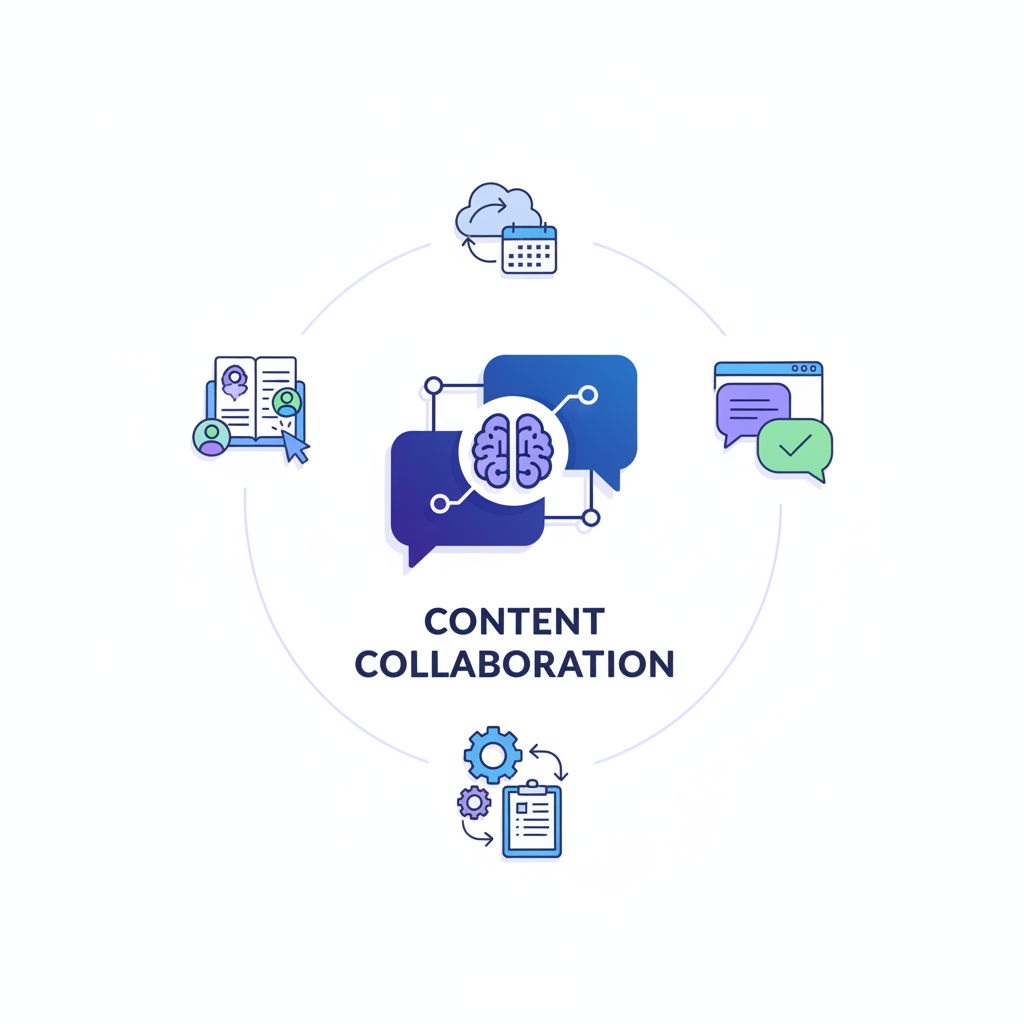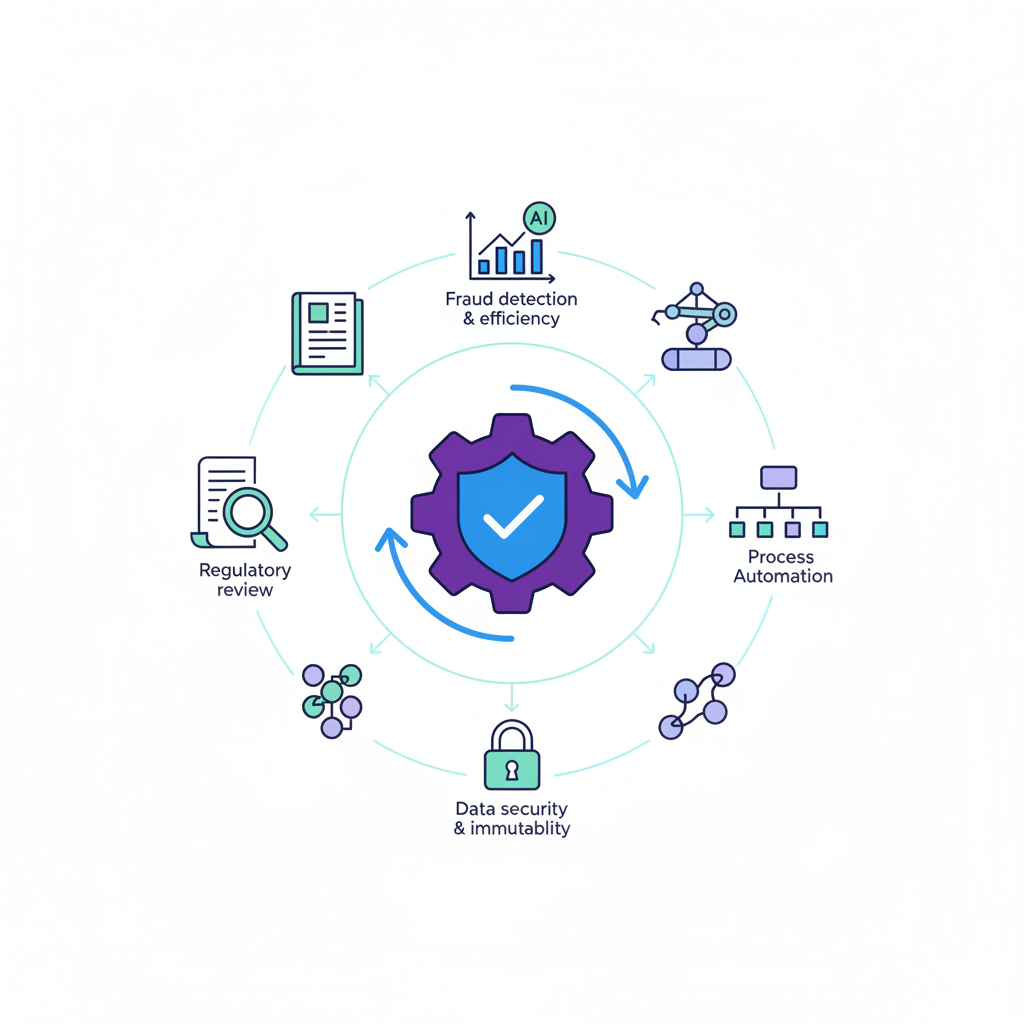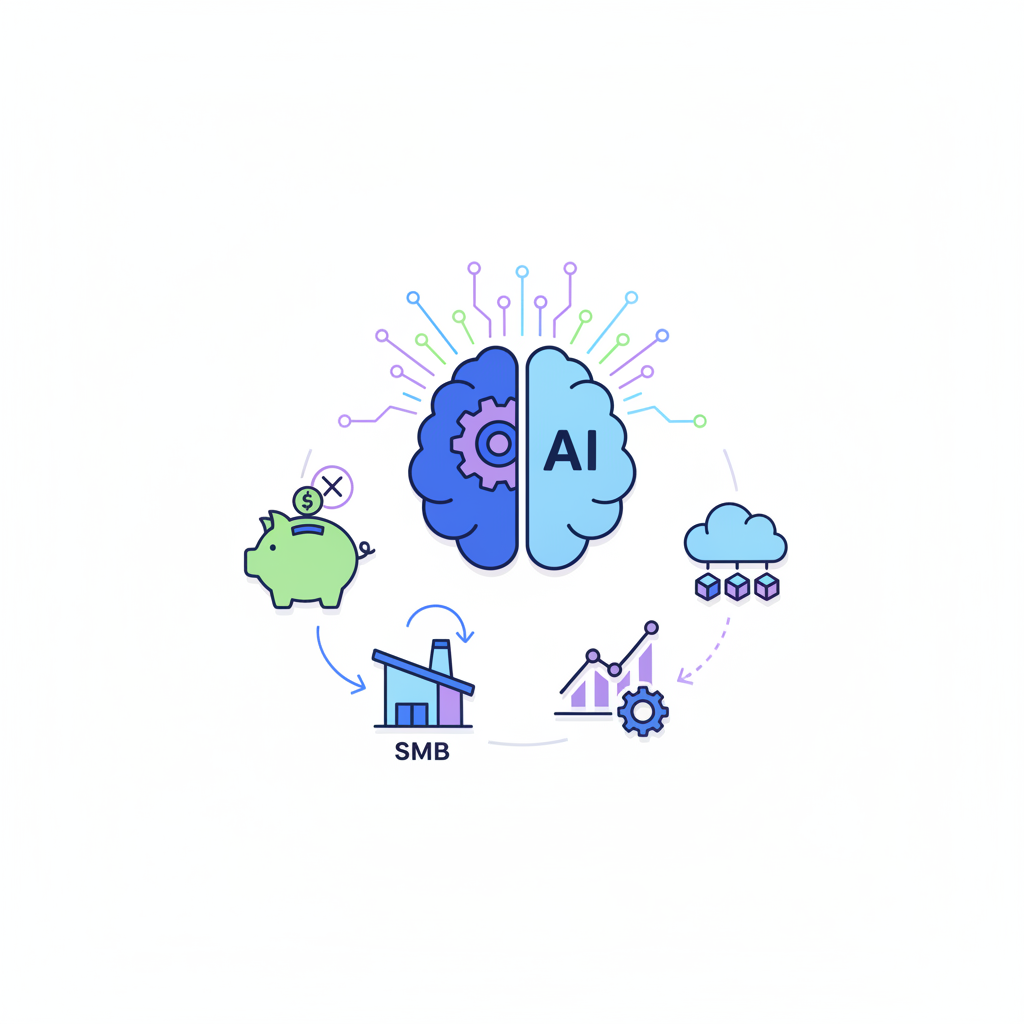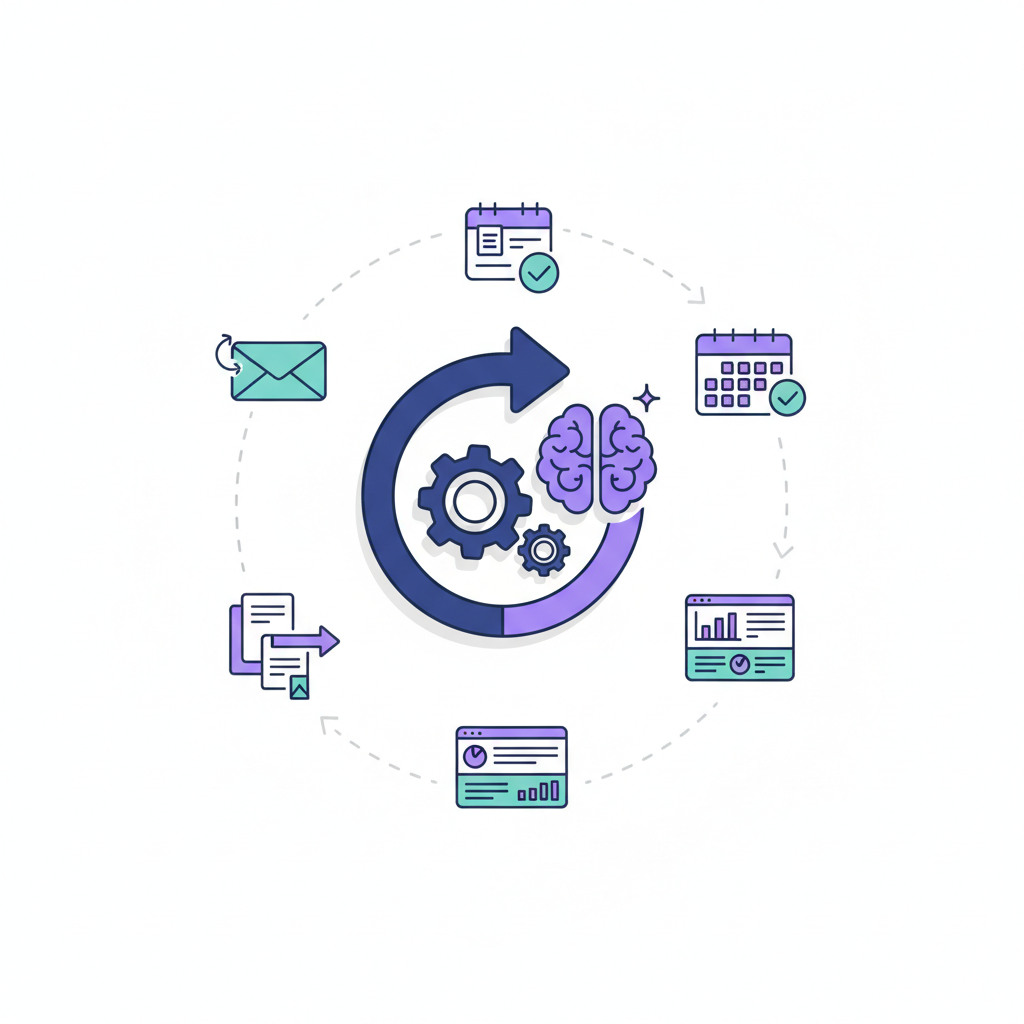Top 10 AI Tools for Content Collaboration
Discover the top 10 AI tools transforming content collaboration in 2025. From Notion AI and Miro Assist to Microsoft 365 Copilot and ChatGPT Team, learn how these tools enhance brainstorming, co-writing, feedback, and project management for seamless team workflows.

Unlocking Collaborative Potential: The Rise of AI in Content Creation
In today's hyper-connected digital landscape, the demand for high-quality, consistent content is ever-increasing, pushing teams to produce more, faster, and with greater impact. However, traditional content creation workflows often grapple with a myriad of challenges: inefficiencies stemming from manual processes, inconsistencies across multiple contributors, and frustrating communication breakdowns, especially prevalent in remote or hybrid team structures. These hurdles can stifle creativity, delay publication, and ultimately impact an organization's ability to engage its audience effectively.
Enter artificial intelligence (AI), a transformative force poised to revolutionize how teams approach content creation. Specifically, AI is emerging as a game-changer in streamlining and enhancing content collaboration. By automating repetitive tasks, providing intelligent insights, and fostering seamless communication, AI collaborative tools are empowering teams to work smarter, not just harder. This article will delve into the top 10 AI tools for content collaboration specifically designed to revolutionize team content workflows. We'll offer in-depth insights into their unique features, practical use cases, and best practices for their implementation. Readers will learn about the significant benefits of integrating AI tools for content collaboration, understand the challenges to overcome, discover key selection criteria, and gain a glimpse into future trends that will shape content creation for years to come, ultimately boosting overall team productivity tools.
The Collaborative Content Landscape: Why AI is a Game-Changer
The evolution of content collaboration has seen a significant shift from siloed individual efforts to integrated, dynamic team endeavors. Modern demands for efficiency, consistency, and rapid iteration necessitate tools that can keep pace. AI addresses these contemporary needs by transforming how teams interact with content at every stage. The detailed benefits of using AI specifically for content collaboration are profound. It ensures improved consistency across multiple writers and content pieces, maintaining a unified brand voice and style. Teams experience faster iteration cycles and significantly reduced bottlenecks in feedback and revision processes, thanks to AI-powered suggestions and summaries. AI can automate summaries of collaborative discussions and meeting notes, ensuring everyone is on the same page without extensive manual effort. This leads to enhanced team communication and a shared understanding of project goals. Furthermore, AI boosts creativity through AI-powered brainstorming and idea generation, helping teams overcome creative blocks and explore new angles. These AI tools are truly becoming essential productivity tools for any modern content team.
AI's role spans across the entire content collaboration workflow, offering specific use cases for AI in different stages. In brainstorming and ideation, AI can generate novel ideas, structure comprehensive outlines, and facilitate visual mind mapping on shared canvases. During drafting and co-writing, AI provides real-time grammar, spelling, style, and tone suggestions, ensuring content quality and brand voice consistency across all contributors. For editing and feedback loops, AI excels at proofreading, summarizing extensive feedback threads, tracking revisions meticulously, and identifying areas for improvement that might be missed by human eyes. Finally, in the approval and publishing stages, AI assists with compliance checks, formatting optimization, and content optimization for various platforms, making the entire process smoother. These AI collaborative tools and AI project management tools are complemented by AI note-taking assistant features, making the entire content lifecycle more efficient through AI automation.
Top 10 AI Tools Revolutionizing Content Collaboration
Selecting the right AI tools for content collaboration is crucial for maximizing team efficiency and output. Our selection criteria for these top 10 tools focused on their ability to offer collaboration-centric features, integrate seamlessly into existing workflows, and provide tangible benefits in co-writing, feedback management, version control, brainstorming, communication, and project management within a team context. These tools go beyond mere content generation; they actively enhance how teams work together.
1. Notion AI
Notion AI transforms the popular workspace into a powerful collaborative content hub. It offers AI-powered summaries of collaborative documents, allowing team members to quickly grasp the essence of lengthy shared pages without reading every word. For team projects, Notion AI assists with content generation, helping draft sections, expand on ideas, or even create entire first drafts within shared pages. Its brainstorming assistance helps teams generate ideas directly within their project notes, while task automation features streamline workflows within shared workspaces, ensuring everyone stays organized and on track.
Ideal Collaborative Use Case: Perfect for teams managing complex projects, knowledge bases, and diverse content types who need a centralized workspace for both content creation and project management. It excels in environments where quick understanding of shared information and efficient task delegation are paramount.
2. Miro Assist
Miro Assist brings AI power to visual collaboration, making it an indispensable tool for creative and strategic content teams. On shared whiteboards, Miro Assist uses AI for generating ideas, helping teams overcome creative blocks and explore new concepts visually. It can cluster sticky notes into themes, making sense of large brainstorming sessions and identifying key insights. The tool also summarizes brainstorming sessions, providing concise recaps for absent team members or for future reference. Furthermore, it aids in creating visual content collaboratively, from diagrams to user flows, enhancing shared understanding and accelerating design-led content initiatives.
Ideal Collaborative Use Case: Best for design teams, marketing strategists, and content teams involved in visual storytelling, ideation workshops, or complex content mapping. It’s invaluable for remote teams needing to replicate the spontaneity and effectiveness of in-person brainstorming.
3. Leexi
Leexi is an AI-powered meeting assistant designed to revolutionize collaborative calls and discussions. Its core strength lies in AI-powered meeting summaries, automatically distilling key points and decisions from team conversations. It excels at action item extraction from collaborative calls, ensuring no task is missed and responsibilities are clearly assigned. Leexi provides accurate transcription for shared review, allowing team members to revisit specific parts of a discussion. Additionally, its sentiment analysis of team discussions can offer insights into team dynamics and potential areas of friction or enthusiasm, fostering more effective communication.
Ideal Collaborative Use Case: Essential for remote or hybrid teams that frequently hold virtual meetings for content planning, feedback sessions, or project reviews. It ensures clarity, accountability, and a comprehensive record of all discussions, making it a top AI note-taking assistant.
4. Slack AI
Slack AI integrates directly into the widely used communication platform, enhancing team collaboration where it happens most. It uses AI for summarizing long threads, allowing team members to quickly catch up on discussions without sifting through hundreds of messages. It can answer questions based on channel history, acting as an intelligent knowledge base for shared information. Slack AI also assists in drafting messages, helping users compose clear and concise communications. Furthermore, it aids in organizing shared channels, making it easier to find relevant information and manage collaborative projects within the platform, making it a powerful AI communication platform.
Ideal Collaborative Use Case: Ideal for any team that relies heavily on Slack for daily communication and project updates. It helps manage information overload, ensures everyone is informed, and streamlines communication for faster decision-making in content workflows.
5. Grammarly Business
Grammarly Business is a robust AI writing assistant tailored for teams, ensuring consistency and quality across all written content. It provides real-time grammar, spelling, style, and tone suggestions across collaborative documents, whether in Google Docs, Microsoft Word, or other platforms. A key feature for teams is its brand voice consistency checks, which enforce specific linguistic guidelines to ensure all content aligns with the company's established tone and style. Teams can also create and share custom style guides, making it easier for multiple writers to adhere to unified standards, significantly enhancing content creation quality.
Ideal Collaborative Use Case: A must-have for any content team, especially those with multiple writers, editors, and diverse content outputs (blogs, marketing copy, internal communications). It ensures professional, error-free, and on-brand content every time.
6. Jasper (or similar AI content generator with team features)
Jasper, or similar advanced AI content generators like Copy.ai or Writesonic with team functionalities, empowers collaborative content creation at scale. These tools offer AI-powered content generation for various formats, from blog posts and social media captions to ad copy and video scripts. They provide team templates to standardize content types and ensure consistency. Crucially, they allow for the implementation of brand voice guidelines, ensuring all AI-generated content aligns with the company's identity. Shared projects facilitate co-creation, where team members can collaborate on prompts, refine outputs, and manage content assets together.
Ideal Collaborative Use Case: Best for marketing teams, agencies, and content departments needing to produce high volumes of diverse content quickly. It accelerates the drafting process and helps maintain brand consistency across various campaigns and platforms.
7. Google Workspace AI (Docs, Meet, etc.)
Google Workspace AI seamlessly integrates AI capabilities across its suite of productivity tools, making it a natural fit for content collaboration. In Google Docs, it offers AI-powered writing assistance, suggesting improvements, summarizing content, and generating drafts. Smart replies in Gmail and Chat streamline communication. Google Meet benefits from AI-powered meeting summaries and automatic transcription, ensuring all discussions are captured and easily reviewable. Real-time co-editing in Docs, Sheets, and Slides, combined with AI suggestions, creates a highly dynamic and efficient collaborative environment for teams working on shared content assets.
Ideal Collaborative Use Case: Ideal for teams already deeply embedded in the Google ecosystem. It leverages familiar tools with added AI intelligence to enhance every stage of content creation, from initial brainstorming to final review and distribution.
8. Microsoft 365 Copilot (Word, Teams, etc.)
Microsoft 365 Copilot represents a significant leap in AI-integrated productivity, offering AI assistance across the entire Microsoft 365 suite. In Word, Copilot helps in drafting, summarizing, and refining content, turning outlines into full documents or condensing lengthy reports. In Teams, it provides meeting summaries, extracts action items, and helps organize discussions, making it a powerful AI communication platform. Its integrated AI across productivity apps means that content created in one application can be seamlessly leveraged and enhanced in another, fostering a truly connected and intelligent collaborative workflow for content teams.
Ideal Collaborative Use Case: Perfect for enterprises and teams heavily invested in the Microsoft 365 ecosystem. Copilot acts as a universal AI assistant, streamlining content creation, communication, and project management across all familiar applications.
9. ClickUp AI (or similar AI-powered project management)
ClickUp AI, and similar AI-powered project management tools like Asana Intelligence or Monday.com AI, are designed to optimize content project workflows. ClickUp AI can generate task descriptions, saving time and ensuring clarity for team members. It summarizes project updates, keeping everyone informed without extensive reading. AI can draft emails for project communications, create detailed subtasks from larger goals, and organize shared workflows for content projects, from ideation to publication. These features transform a project management tool into a proactive AI project management tool for content teams.
Ideal Collaborative Use Case: Essential for content teams managing complex editorial calendars, multiple campaigns, or large-scale content initiatives. It brings intelligence to project planning, execution, and tracking, ensuring content projects stay on schedule and within scope.
10. ChatGPT Team/Enterprise
ChatGPT Team and Enterprise versions offer advanced AI capabilities within a secure, collaborative environment. Teams can create custom GPTs tailored for specific content tasks, such as generating blog post outlines, drafting social media captions, or refining SEO keywords. It provides a shared knowledge base, allowing the AI to learn from and leverage team-specific data and style guides. These versions facilitate advanced brainstorming, content generation, and refinement within a secure team environment, ensuring data privacy and control over AI interactions. It's one of the most versatile AI collaborative tools for diverse content needs.
Ideal Collaborative Use Case: Ideal for content teams looking for highly customizable AI assistance, secure data handling, and the ability to scale AI usage across various content types and team members. It's particularly useful for innovative teams pushing the boundaries of AI-assisted content.
Choosing the Right AI Collaboration Tool for Your Team
Selecting the best AI tools for content collaboration requires a thoughtful assessment of your team's unique needs and existing infrastructure. There are several key criteria for selection that will guide you toward the most effective solutions. First, consider your team size and structure: a solo creator will have different needs than a large enterprise with multiple departments. Second, evaluate your content type and volume; whether you primarily produce blog posts, video scripts, marketing copy, or technical documentation will influence the tool's suitability. Third, assess your budget and scalability requirements, looking at free tiers, subscription models, and enterprise solutions.
Fourth, integration capabilities are paramount; ensure the tool is compatible with your existing CMS (like WordPress), project management platforms (like Asana or Trello), and communication platforms (like Slack or Teams). Fifth, pinpoint your specific collaborative needs: do you prioritize visual collaboration, advanced writing assistance, robust project tracking, or communication streamlining? Finally, and critically, consider data security and privacy, ensuring the tool complies with relevant regulations and offers robust data handling and access controls. A comparative analysis based on these factors will help you identify the best AI tools for content collaboration for your specific context and ensure your collaboration software investment yields maximum returns.
Integrating AI Tools for Seamless Collaborative Workflows
Successfully integrating AI tools for content collaboration into your existing workflows requires strategic planning and execution. One of the most effective strategies for smooth implementation is a phased rollout, starting with pilot programs to test and refine usage with a smaller group before scaling. This allows for adjustments and addresses potential issues early on. Comprehensive training and ongoing support are crucial for user adoption; team members need to understand not just how to use the tools, but why they are beneficial and how they fit into their daily tasks.
Leveraging API integrations with your existing tech stack is another vital step. Connecting AI tools with your CMS (e.g., WordPress), project management platforms (e.g., Asana, Trello), and communication platforms (e.g., Slack, Teams) creates a cohesive ecosystem, minimizing context switching and maximizing efficiency. Establishing clear guidelines and best practices for AI usage within the team ensures consistency and responsible application. Finally, regularly evaluating tool performance and actively soliciting team feedback allows for continuous improvement and ensures the AI solutions remain aligned with evolving collaborative needs, enhancing overall AI automation and strengthening your AI project management tools and AI communication platform.
Best Practices for AI-Powered Content Collaboration
To truly maximize team efficiency and quality with AI tools for content collaboration, adopting specific best practices is essential. First, define clear roles and responsibilities within your team. While AI can automate many tasks, it's crucial to emphasize the "human in the loop" for oversight, strategic direction, and final approval. AI is an assistant, not a replacement for human creativity and judgment. Second, establish a "human oversight" policy for all AI-generated content to ensure accuracy, maintain the desired tone of voice, and consistently adhere to brand guidelines. This prevents factual errors or off-brand messaging from reaching your audience.
Third, regularly review and refine AI outputs. Treat AI as a powerful first-draft generator or idea catalyst, but always apply critical human editing and refinement. Fourth, foster a culture of experimentation and continuous learning with new AI features. The AI landscape evolves rapidly, and encouraging your team to explore and adapt will keep your collaborative efforts at the cutting edge. Fifth, prioritize data privacy and security protocols when using AI collaborative tools, especially when handling sensitive information. Finally, encourage robust feedback loops on AI tool effectiveness within the team. Understanding what works, what doesn't, and where improvements can be made is key to optimizing your productivity tools and ensuring long-term success in content collaboration.
Future Trends and Ethical Considerations in AI Collaboration
The road ahead for AI tools for content collaboration promises even more sophisticated and integrated capabilities. We can anticipate hyper-personalized content generation at scale, where AI not only creates content but tailors it precisely to individual audience segments based on real-time data. More intuitive human-AI interfaces and proactive AI assistance will emerge, with tools anticipating needs and offering solutions before being explicitly prompted. Advanced AI for conflict resolution and team dynamics analysis could even help foster healthier and more productive collaborative environments.
However, this rapid advancement also brings critical ethical concerns. Addressing bias in AI outputs is paramount to ensure fairness and inclusivity in content. Intellectual property rights surrounding AI-generated content will continue to be a complex legal and creative challenge. Furthermore, the evolving role of human creators in an AI-powered world requires careful consideration, focusing on how AI augments rather than diminishes human talent. The increasing importance of responsible AI development and usage will be a defining theme for AI tools for content creation 2025 and beyond, ensuring that innovation aligns with ethical principles.
FAQs About AI Tools for Content Collaboration
Q: How do AI tools specifically improve content quality in a collaborative setting?
A: AI tools enhance content quality by ensuring consistency in grammar, style, and brand voice across multiple contributors. They provide real-time suggestions, catch errors, summarize feedback, and help refine content, leading to more polished and professional outputs.
Q: Can AI replace human content collaborators or editors?
A: No, AI cannot replace human content collaborators or editors. AI serves as a powerful assistant, automating repetitive tasks and generating drafts, but human oversight is crucial for ensuring accuracy, creativity, emotional intelligence, strategic alignment, and brand authenticity.
Q: What are the biggest challenges when adopting AI for team content creation?
A: Key challenges include ensuring data privacy and security, integrating AI tools with existing workflows, overcoming initial team resistance to new technology, maintaining a consistent brand voice, and establishing clear guidelines for human oversight of AI-generated content.
Q: How do I ensure data privacy and security when using AI collaboration tools?
A: To ensure data privacy and security, choose reputable AI tools with strong encryption and compliance certifications. Understand their data handling policies, implement strict access controls, and avoid inputting highly sensitive or proprietary information into public AI models.
Q: Are these tools suitable for small teams or just large enterprises?
A: Many AI tools for content collaboration offer scalable solutions, with free tiers or affordable plans suitable for small teams and solopreneurs, alongside enterprise-grade features for larger organizations. The benefits of improved efficiency and quality apply to teams of all sizes.
Embrace the Future: Elevating Content Collaboration with AI
The transformative power of AI in content collaboration is undeniable, ushering in an era of unprecedented efficiency, quality, consistency, and team synergy. As we've explored, AI tools for content collaboration are no longer a futuristic concept but an immediate reality, offering tangible benefits across every stage of the content lifecycle. From intelligent brainstorming and streamlined drafting to precise editing and automated project management, these tools empower teams to overcome traditional bottlenecks and achieve more with less effort.
We've delved into a diverse range of best AI tools for content collaboration, each offering unique features to address specific collaborative needs, from visual ideation with Miro Assist to comprehensive project oversight with ClickUp AI, and intelligent communication with Slack AI. The key to unlocking their full potential lies in strategic implementation, carefully tailored to your team's specific size, content types, and existing workflows. AI isn't just a trend; it's an essential partner for modern content teams, augmenting human capabilities and fostering a more productive, creative, and cohesive working environment. We encourage you to explore the featured tools, assess your team's specific needs, and strategically integrate AI to elevate your collaborative content efforts. By embracing these innovations, your team can achieve unprecedented productivity and deliver exceptional content creation that truly resonates with your audience.
Featured Tools

10Web is an AI-powered WordPress platform that offers automated website building, hosting, and optimization with AI assistance for content and image generation.

A global creative platform connecting businesses with freelance designers for custom graphic design projects.

A1.art is an AI art generator that transforms text descriptions into unique digital artworks across various styles.

Acquire.io is a customer engagement platform offering live chat, AI chatbots, co-browsing, and video chat to enhance customer support and sales.

A customer experience automation platform combining email marketing, marketing automation, and CRM with AI-powered personalization.
Top AI Categories
Related Articles

AI for financial services: compliance & automation
Discover how AI is revolutionizing financial services through advanced compliance automation, real-time fraud detection, regulatory reporting, and hyper-personalized customer experiences. Explore the future of intelligent, efficient, and secure banking.

How SMBs can adopt AI without big spending
Discover how small and medium businesses can adopt AI affordably. This practical guide covers low-cost tools, quick wins, real-world examples, and step-by-step strategies to integrate AI without breaking the bank.

Top 10 AI tools for Enterprise Workflow Automation
Enterprises are turning to AI-powered workflow automation to eliminate manual processes, cut costs, and accelerate strategic execution. Unlike traditional automation, AI can handle unstructured data and make intelligent decisions, offering profound benefits across finance, HR, and IT. This guide curates the top 10 AI tools—from RPA leaders like UiPath and Automation Anywhere to iPaaS solutions like Workato and low-code platforms like Microsoft Power Automate—providing a blueprint for building a more agile and resilient organization.